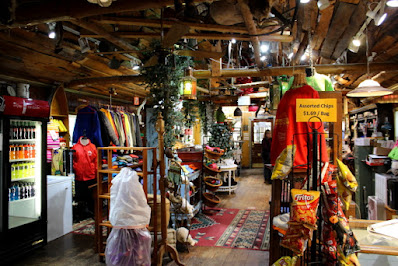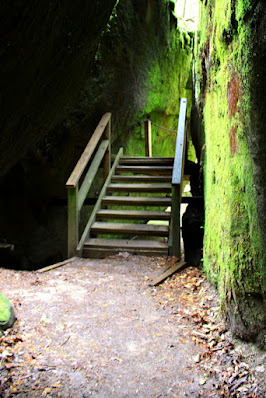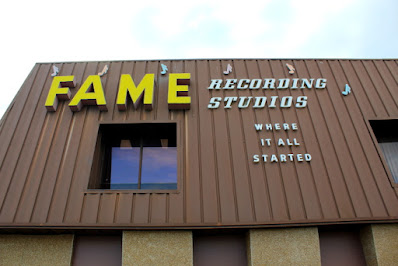 |
| Picture by Kolohe |
 |
| Picture by Kolohe |
Dismals Canyon is one of only three places in the world where glow worms are found - the other two places are Australia and New Zealand. Fortunately, we were in Alabama; unfortunately, we were not there at night to see the glow worm display. We did, however, have a very enjoyable hike in the canyon.
Access to the canyon is through a "country store" that contains a wide selection of souvenirs, some of which are quite unique. Their web site states: "Shop at the Old Country Store in an atmosphere as old as the dust between the floorboards."
 |
| Picture by Kolohe |
After descending several flights of stairs, there is an old mill site along the creek and then the trail winds down to the canyon floor. Once at the bottom of the canyon, the trail forks to the left and right. We selected the left trail that crossed a wooden bridge and then followed a small stream that meandered around large boulders, trees, and other obstacles. Eventually, the trail looped around and arrived back at the trail junction.
 |
| Picture by Kolohe |
 |
| Picture by Kolohe |
 |
| Picture by Kolohe |
 |
| Picture by Kolohe |
 |
| Picture by Kolohe |
 |
| Picture by Kolohe |
 |
| Picture by Kolohe |
 |
| Picture by Kolohe |
Russellville (population 10,855) is described as the town in the George Luca film American Graffiti. After driving down Main Street past the Roxy Theater and Court House, Kolohe wanted to stop so she could take pictures of a unique Russellville police vehicle. We could not find a parking place, so Kolohe told me to drive around the block while she photographed the vehicle. After going around the block, I was just about back to where she was standing when I saw her trying to get into someone's car. She freaked out the driver before she could explain that she had the wrong vehicle.
 |
| Picture by Kolohe |
 |
| Picture by Kolohe |
 |
| Picture by Kolohe |
As we were entering Tuscumbia (population 9,054), we noticed a small one-room log cabin adjacent to the highway (Jackson Military Road). A placard stated that the cabin was constructed in about 1815 by Michael Dickson, the first white settler in the area. The log cabin served as the Coldwater Stagecoach Stop and was also operated as a hotel.
 |
| Picture by Kolohe |
Just a short distance away we drove by an elephant statue in someone's front yard. Kolohe had to stop and take a picture because she said that the statue looked like "Big Al," mascot for the Alabama Crimson Tide football team.
 |
| Picture by Kolohe |
While we were in Tuscumbia we visited Ivy Green, Hellen Keller's birthplace, and saw the water-well pump where "one of the world's great miracles" occurred.
Helen Keller was born as a healthy child on June 27, 1880, but 19 months later she contracted a severe illness that left her blind and deaf. When Helen was almost seven-years old, her parents hired Anne Sullivan to be her teacher and Helen's life was changed forever.
One spring day when Anne was pumping water from the well, she held Helen's hand in the stream of water. As water was running over Anne's hand, Anne typed out "w-a-t-e-r" several times on Helen's arm. Helen made the connection and by the end of the day she had learned 30 words using the tap method. Within a few months she knew 625 words and then started learning how to write.
By 10 years of age she had mastered Braille and learned how to use a typewriter. By age 16 she could speak well enough to attend preparatory school and college and in 1904 she graduated 'cum laude' from Radcliffe College.
Throughout her life she helped the blind and deafblind around the world, lecturing in more than 25 countries. Gifts and statues from around the world that she received for her lectures are on display in the house and garden area.
Her teacher, Anne Sullivan, became known as "The Miracle Worker" for her "lifetime dedication, patience and love to a half-wild, southern child trapped in a world of darkness." There is an outdoor theater on the property where each summer William Gibson's play "The Miracle Worker" is performed.
 |
| Picture by Kolohe |
 |
| Picture by Kolohe |
 |
| Picture by Kolohe |
 |
| Picture by Kolohe |
 |
| Picture by Kolohe |
 |
| Picture by Kolohe |
 |
| Picture by Kolohe |
In 1925 Helen appealed to Lions International to make themselves "Knights of the Blind in this crusade against darkness," and the Lions accepted the challenge. Sight conservation is still the leading service project for Lions International.
Aluminum was needed to support the Defense Department's demand just prior to WW II, so in 1941 Reynolds Aluminum built a large manufacturing plant in the Shoals area of Alabama to support the anticipated war effort. The Alabama plant location was selected because of the abundant electrical power available from the Tennessee Valley Authority (TVA).
After the War, Reynolds continued to operate the facility until April 1999, when the plant was sold to the Wise Metals Group, making Wise the world's leading processor and supplier of recycled aluminum.
In 2012, Wise donated all of the recycled aluminum needed for artisan Audwin McGee to make a series of "Singing River Sculptures" to honor the area's 50-year old music heritage. To date, two 18-20 feet tall statues have been erected, one each in Sheffield and Muscle Shoals. Additional statues are planned for Tuscumbia and Florence.
Even though people think the Sheffield sculpture looks like Elvis, McGee said that the sculpture is just a generic representation of 1950s musicians. However, the Muscle Shoals sculpture of a bass player sitting on a session stool is modeled after Rhythm Section bassist David Hood.
Muscle Shoals (population 16,275) now calls itself the "Hit Recording Capital of the World" because there are several famous recording studios in the area that have produce so many top hits.
The extensive list of musicians that recorded songs at the Muscle Shoals Sound Studio include: Rolling Stones, Aretha Franklin, George Michael, Willy Nelson, Joe Crocker, Paul Simon, Bob Seger, Rod Stewart, Cher, Cat Stevens, and more.
However, it is Rick Hall's FAME Studio that is credited with producing the Muscle Shoals Sound. Musicians that have recorded at FAME include: Rolling Stones, Otis Redding, Wilson Picket, Solomon Burke, Aretha Franklin, Bobby Gentry, George Jones, Roy Orbison, Gatlin Brothers, Mac Davis, and more
BONUS PICTURE
We went to the new Elvis movie this week and Elvis was in the building!
 |
| Photographer Unknown |
BONUS-BONUS PICTURES BY KOLOHE






























































No comments:
Post a Comment